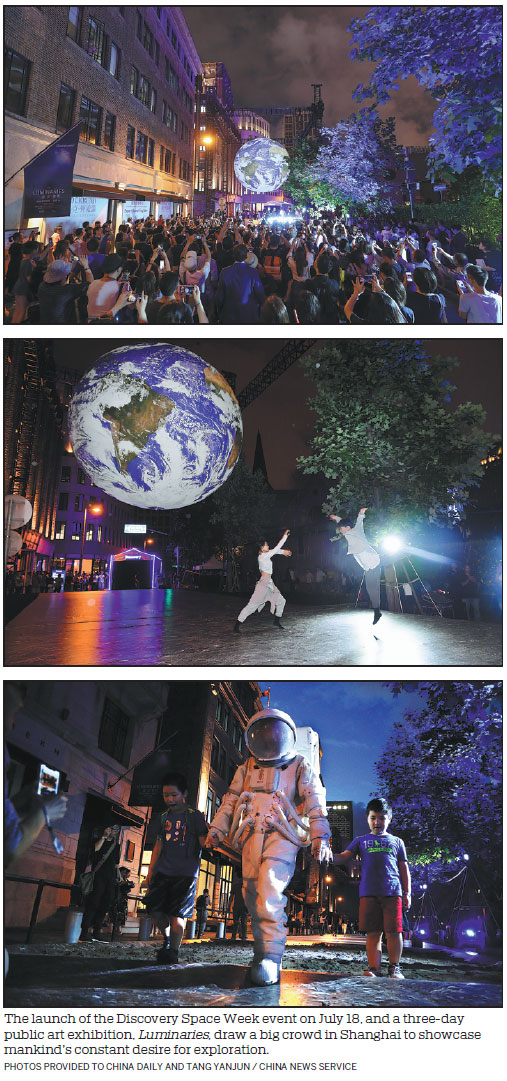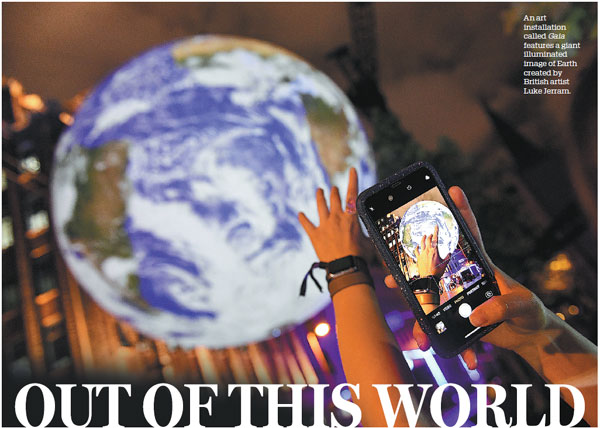Out of this world
A weeklong event in Shanghai celebrating the 50th anniversary of the historic moon landing offered visitors a new perspective of their home planet, Zhang Lei reports.
The entire world has joined together to celebrate the 50th anniversary of the first human landing on the moon this summer, and Shanghai was keen to follow suit with the launch of its Discovery Space Week event on July 18, and a three-day public art exhibition, Luminaries.
An art installation featuring a giant illuminated image of Earth created by pioneering British artist Luke Jerram appeared on Yuanmingyuan Road on the Bund. The touring artwork was designed by the artist to simulate the view that Neil Armstrong saw from the moon half a century ago.
Named Gaia after the Greek goddess of the Earth, the 7-meter-wide globe suspended high above the road features a super-high-definition image of the Earth's surface taken by NASA.

Although the installation is 1.8 million times smaller than the Earth, people who view it from 211 meters away are able to view the Earth from the same perspective that the Apollo 11 crew witnessed from the surface of the moon in 1969.
As well as offering visitors a new perspective of their home planet, the event aims to encourage people to move forward in the spirit of curiosity embodied by space exploration, organizers say.
In order to maximize the display of Gaia and the "moon perspective", a 200-meter stretch of Yuanmingyuan Road was decorated like the surface of the moon. Covering an area of around 1,000 square meters, it also features a number of exhibition spaces.
"We have long been conveying the spirit of mankind's constant desire for exploration. We now hope to let people experience it offline, so that they can appreciate the advances in human technology," says Tony Qiu, general manager of Discovery Group for China and South Korea. "We are offering audiences the chance to re-imagine the future."
When visitors enter the "Discovery station", they first have to go through an artistic recreation of the universe before they arrive at the "moon walk" area - a simulated lunar environment featuring a rover and astronauts.
The "first step" area simulates the landing environment for the lunar spacecraft, where visitors have the chance to leave their own footprint on the surface of the moon.
An "information station" presents documentaries about space to help evoke the spirit of exploration. Finally, at the "best observation point", the audience can look up and see Gaia.
Several space-themed Discovery films pay tribute to NASA's 60th anniversary and the moon landings. Above And Beyond: Nasa's Journey To Tomorrow, and Apollo: The Forgotten Films and the popular series How The Universe Works were produced to mark this year's anniversary.
Simon Robinson, global chief financial officer and president of Asia Pacific, Discovery Group, says Chinese people have been fascinated with the moon since ancient times.
"We are presenting people with the opportunity to experience things, rather than just watch them on television," he says. Discovery hopes to develop more location-based entertainment projects in China, Robinson adds, following the success of the Discovery Adventures Moganshan Park, a theme park for outdoor exploration, which opened in Zhejiang province in 2016.

While people are curious and passionate about similar things the world over, specific tastes vary from country to country, Qiu says, underlining his goal to export Chinese content overseas and tailor foreign productions to domestic audiences.
One example of this is the upcoming Chinese version of the popular reality show Say Yes to The Dress. Another is Ed Stafford: First Man Out, a survival program that Discovery coproduced with Bilibili, a video sharing platform that features bullet words - floating on-screen viewer comments.
The wilderness survival show has been a hit with Chinese viewers. Filming of the second series continued straight after shooting of the first season, where the production team visited some of China's most challenging, wild and remote locations suitable for tests of survival. Qiu says that preparations for the second season are complete, and the first episode was filmed at the end of July. Shooting will continue through November and the program is due for release in China in January, and in the rest of the world the following month.
In China, the traditional view of documentary is generally a fairly narrow one, where viewers are generally perceived as high-income, more highly educated and of a higher social standing.
To counter this, Discovery, as a major player in real-life entertainment business, prefers to create products covering different genres in real life and bring in-depth and nonfiction programs to the audiences, rather than documentaries in the more traditional sense.
"For example, traditional documentaries are more like the famous Masters in the Forbidden City, but Discovery's nonfiction films often combine factual content with more entertaining elements. The market for traditional documentaries in China is relatively small but we hope to expand our documentaries to the nonfiction film market and reach a wider audience," Qiu says.
"In the past, typical Discovery viewerships tended to be older males. But we believe this group should include younger people. Unscripted cooking and travel shows will attract a more balanced gender ratio."
To create more local content, Discovery recently teamed up with Mango TV to launch Kung Fu Apprentice - a martial arts reality show - which is due to air on the channel on Sept 4.
Contact the writer at zhanglei@chinadaily.com.cn
|
An art installation called Gaia features a giant illuminated image of Earth created by British artist Luke Jerram. |

(China Daily Global 08/14/2019 page15)



















